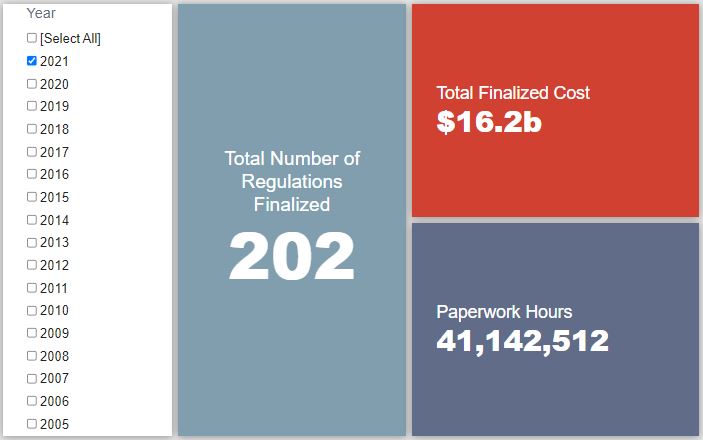Week in Regulation
October 4, 2021
DACA Proposal Hits the Books
Following a couple weeks of relatively understated action, last week saw regulatory activity push back into the billion-dollar threshold. The primary reason for this was the Biden Administration’s proposed rule regarding Deferred Action for Childhood Arrivals (DACA). This action wasn’t the only one to exceed nine digits of economic impact, though; a health care rule brought significant cost savings as well. Across all rulemakings, agencies published $6.6 billion in total net costs but cut 2.7 million annual paperwork burden hours.
REGULATORY TOPLINES
- Proposed Rules: 39
- Final Rules: 93
- 2021 Total Pages: 54,495
- 2021 Final Rule Costs: $16.2 billion
- 2021 Proposed Rule Costs: $185 billion
NOTABLE REGULATORY ACTIONS
The primary rulemaking of the week was the Department of Homeland Security’s (DHS) proposed rule regarding “Deferred Action for Childhood Arrivals.” This action marks the latest installment in the ongoing legal saga of the program created under the Obama Administration via a memorandum from then-DHS Secretary Janet Napolitano. The program has famously been a legal and political football ever since. In light of legal challenges to the program – including a recent District Court decision on the matter – DHS is formally attempting to implement it via full notice-and-comment rulemaking.
Given the level of uncertainty in place surrounding the legal status of the policy, DHS elected to include two cost-benefit analyses in the proposal’s preamble. The “No Action Baseline” analysis starts from a position of “a state of the world under the current DACA policy; that is, the policy initiated by the guidance in the Napolitano Memorandum in 2012.” The other, “Pre-Guidance” baseline describes the effects of this proposal becoming policy in an otherwise DACA-less world. According to DHS, since the latter baseline “gives clarity about the impact of the DACA policy as such,” then it is “the more useful baseline for understanding the costs and benefits of that policy.” Under that analytical framework, DHS estimates that the (largely administrative) costs involved in establishing the DACA program would be roughly $8 billion over a 20-year window, or approximately $410 million on an annualized basis.
TRACKING THE ADMINISTRATIONS
As we have already seen from executive orders and memos, the Biden Administration will surely provide plenty of contrasts with the Trump Administration on the regulatory front. And while there is a general expectation that the new administration will seek to broadly restore Obama-esque regulatory actions, there will also be areas where it charts its own course. Since the AAF RegRodeo data extend back to 2005, it is possible to provide weekly updates on how the top-level trends of President Biden’s regulatory record track with those of his two most recent predecessors. The following table provides the cumulative totals of final rules containing some quantified economic impact from each administration through this point in their respective terms.
![]()
Despite the sizeable overall cost increase from the DACA proposal, in terms of final rules, the Biden Administration saw its regulatory ledger decrease by a solid clip. The primary reason for this was a Departments of Health & Human Services and Treasury rule adjusting certain Affordable Care Act programs for 2022 and onward. One primary component of the rule – from a costs/savings perspective, at least – is the recission of requirements implemented by a 2019 rule regarding billing practices for abortion services. The agencies estimate that removing the administrative burdens involved in these requirements would save affected entities roughly $1.3 billion and 2.3 million annual paperwork burden hours. Meanwhile, the other administrations saw only modest increases in their respective regulatory tallies.
THIS WEEK’S REGULATORY PICTURE
This week, the National Labor Relations Board’s (NLRB) general counsel penned a memo reinstating the view that some college athletes are employees.

Via @NLRBGC Twitter
On September 29, NLRB general counsel Jennifer Abruzzo issued a memorandum on the subject of players at academic institutions. The memorandum reinstates and adds to a 2017 memorandum that found that athletes receiving scholarships and other benefits from universities are considered employees under the National Labor Relations Act (NLRA). That 2017 memo had been rescinded by the Trump Administration’s NLRB.
The upshot of the memo is that the NLRB would be likely to find universities in violation of the NLRA if they retaliate against scholarship athletes who attempt to organize. In addition, violations may also occur if universities incorrectly label such persons “student athletes” rather than employees, because the term has a “chilling effect” on students that leads them to believe they are not actually employees.
While the new memo reinstates the 2017 memo, it also supplements that memo’s findings due to recent events. Abruzzo cites three major factors that add further evidence that scholarship athletes are employees. The first is the U.S. Supreme Court’s ruling in NCAA v. Alston, which recognized that college sports are a profit-making enterprise and, as such, institutions cannot artificially limit scholarships, payments for tutoring, and paid internships. The second is the NCAA’s subsequent decision to suspend its rules that limited athletes from profiting from their name, image, and likeness. Third, in the wake of activism on social and racial justice issues following the murder of George Floyd and expressions of concern about safety during the COVID-19 pandemic, athletes “have been engaging in collective action at unprecedented levels.” Such activism “directly concerns terms and conditions of employment and is concerted protected activity” under the NLRA.
While the memo does not technically change any law or regulation, it does reinforce Abruzzo’s opinion that existing laws are sufficient to bring actions against institutions if they violate the rights of scholarship athletes.
TOTAL BURDENS
Since January 1, the federal government has published $201.2 billion in total net costs (with $16.2 billion in new costs from finalized rules) and 42.7 million hours of net annual paperwork burden increases (with 41.1 million hours in increases from final rules).












